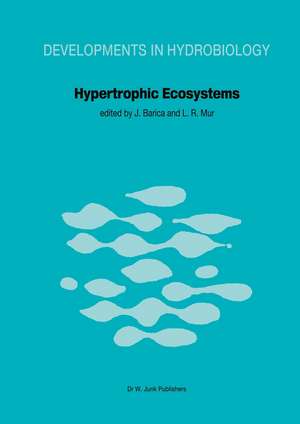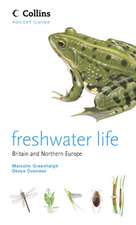Hypertrophic Ecosystems: S.I.L. Workshop on Hypertrophic Ecosystems held at Växjö, September 10–14, 1979: Developments in Hydrobiology, cartea 2
Editat de J. Barica, L.R. Muren Limba Engleză Paperback – 3 noi 2011
| Toate formatele și edițiile | Preț | Express |
|---|---|---|
| Paperback (1) | 657.08 lei 6-8 săpt. | |
| SPRINGER NETHERLANDS – 3 noi 2011 | 657.08 lei 6-8 săpt. | |
| Hardback (1) | 1084.16 lei 38-44 zile | |
| SPRINGER NETHERLANDS – 30 noi 1980 | 1084.16 lei 38-44 zile |
Din seria Developments in Hydrobiology
- 18%
 Preț: 1229.10 lei
Preț: 1229.10 lei - 18%
 Preț: 959.98 lei
Preț: 959.98 lei - 18%
 Preț: 963.91 lei
Preț: 963.91 lei - 15%
 Preț: 648.24 lei
Preț: 648.24 lei - 15%
 Preț: 637.89 lei
Preț: 637.89 lei -
 Preț: 378.25 lei
Preț: 378.25 lei - 15%
 Preț: 644.95 lei
Preț: 644.95 lei - 18%
 Preț: 952.09 lei
Preț: 952.09 lei - 20%
 Preț: 558.87 lei
Preț: 558.87 lei - 18%
 Preț: 1833.65 lei
Preț: 1833.65 lei -
 Preț: 393.59 lei
Preț: 393.59 lei -
 Preț: 406.54 lei
Preț: 406.54 lei - 18%
 Preț: 1226.73 lei
Preț: 1226.73 lei - 18%
 Preț: 956.99 lei
Preț: 956.99 lei -
 Preț: 388.87 lei
Preț: 388.87 lei - 24%
 Preț: 1060.53 lei
Preț: 1060.53 lei - 18%
 Preț: 1229.28 lei
Preț: 1229.28 lei - 20%
 Preț: 569.31 lei
Preț: 569.31 lei -
 Preț: 368.79 lei
Preț: 368.79 lei - 24%
 Preț: 817.48 lei
Preț: 817.48 lei - 18%
 Preț: 958.25 lei
Preț: 958.25 lei - 18%
 Preț: 953.03 lei
Preț: 953.03 lei -
 Preț: 384.75 lei
Preț: 384.75 lei - 24%
 Preț: 1582.95 lei
Preț: 1582.95 lei - 24%
 Preț: 1051.70 lei
Preț: 1051.70 lei - 18%
 Preț: 943.57 lei
Preț: 943.57 lei - 18%
 Preț: 1235.76 lei
Preț: 1235.76 lei - 24%
 Preț: 800.05 lei
Preț: 800.05 lei - 24%
 Preț: 803.57 lei
Preț: 803.57 lei - 18%
 Preț: 948.29 lei
Preț: 948.29 lei
Preț: 657.08 lei
Preț vechi: 773.03 lei
-15% Nou
Puncte Express: 986
Preț estimativ în valută:
125.75€ • 136.54$ • 105.63£
125.75€ • 136.54$ • 105.63£
Carte tipărită la comandă
Livrare economică 23 aprilie-07 mai
Preluare comenzi: 021 569.72.76
Specificații
ISBN-13: 9789400992054
ISBN-10: 940099205X
Pagini: 368
Ilustrații: XVIII, 348 p.
Dimensiuni: 210 x 297 x 19 mm
Greutate: 0.88 kg
Ediția:Softcover reprint of the original 1st ed. 1980
Editura: SPRINGER NETHERLANDS
Colecția Springer
Seria Developments in Hydrobiology
Locul publicării:Dordrecht, Netherlands
ISBN-10: 940099205X
Pagini: 368
Ilustrații: XVIII, 348 p.
Dimensiuni: 210 x 297 x 19 mm
Greutate: 0.88 kg
Ediția:Softcover reprint of the original 1st ed. 1980
Editura: SPRINGER NETHERLANDS
Colecția Springer
Seria Developments in Hydrobiology
Locul publicării:Dordrecht, Netherlands
Public țintă
ResearchCuprins
Session 1: Definition, characterization and causes of hypertrophy.- The summer limnology of Lake Waahi, New Zealand.- Identification of different phosphorous forms and their role in the eutrophication process of Lake Balaton.- Metalimnetic gradient and phosphorus loss from the epilimnion in stratified eutrophic lakes.- The influence of sediments on changed phosphorus loading to hypertrophic L. Glumsø.- The cyanobacterium Microcystis aeruginosa kg. and the nitrogen cycle of the hypertrophic Lake Brielle (The Netherlands).- Comparison of hypertrophy on a seasonal scale in Dutch inland waters.- Control of undesirable algae and induction of algal successions in hypertrophic lake ecosystems.- Occurrence of Oscillatoria agardhii and some related species, a survey.- The influence of periodicity in light conditions, as determined by the trophic state of the water, on the growth of the green algae Scenedesmus protruberans and the cyanobacterium Oscillatoria agardhii.- The role of microlayers in controlling phytoplankton productivity.- Short-term load-response relationships in shallow, polluted lakes.- The importance of trophic-level interactions to the abundance and species composition of algae in lakes.- Vegetation changes in the nutrient-rich shallow Lake Hjälstaviken.- N2-fixing cyanobacteria; why they do not become dominant in Dutch, hypertrophic lakes.- Session 2: Stability of hypertrophic ecosystems and causes of hypertrophy.- Nirate overdose: effects and consequences.- A chemical model to describe nutrient dynamics in lakes.- Changes in the respiration and anaerobic nutrient regeneration during the transition phase of reservoir development.- Modelling carbon and phosphorus in a small hypertrophic North German lake.- An algal bloom model as a tool to simulate managementmeasures.- Phosphorus stability in a hypereutrophic lake.- Structural and functional quantification in a series of Hungarian hypertrophic shallow lakes.- Muddy odour in fish from hypertrophic waters.- The importance of hydrologic factors on the relative eutrophic impacts of point and non-point pollution in a reservoir.- Environmental constraints on Anabaena N2- and CO2-fixation: effects of hyperoxia and phosphate depletion on blooms and chemostat cultures.- Toxicity fluctuations and factors determining them.- Stability and multiple steady states of hypereutrophic ecosystems.- Session 3: Foodchain properties, productivity and utilization of hypertrophic ecosystems.- On the role of soil in the maintenance of fish ponds’ fertility.- Fish as a factor controlling water quality in ponds.- The role of fishery management in counteracting eutrophication.- Fish production in some hypertrophic ecosystems in South India.- Session 4: Rehabilitation.- Enrichment and recovery of a Malaysian reservoir.- Lake treatment with hydrogen peroxide.- Characterization of the recovery processes in hypertrophic lakes in terms of actual (lake water) and potential (algal assay) chloropically.- Morphometrically conditioned eutrophy and its amelioration in some British Columbia lakes.- Hartbeespoort Dam - a case study of a hypertrophic, warm, monomictic impoundment.- Cascade reservoirs as a method for improving the trophic state downstream.- Concluding Remarks.- Summaries and Abstracts.- The effect of pig manure and mineral fertilization on a eutrophic lake ecosystem.- Hypertrophy in slow flowing rivers.- CO2-uptake as a measure of bacterial production.- Response of shallow hypertrophic lakes to reduced nutrient loading.- Fish as a regulator of structure and function in eutrophic lake ecosystems.-Algenbekämpfung durch Zusatz von Kalk und Dolomithydrat.- Possible triggering mechanisms for the collapse of Aphanizomenon-flos-aquae blooms.- Self-purification and respiration in polysaprobic area of natural flowing waters receiving raw domestic sewage.- Short-circuit metabolism in highly eutrophic lakes - relationship between primary production and decomposition rates.- Heterotrophic functions in the freshwater carbon cycle.- Effects of temperature and temperature-nutrient interactions on phytoplankton growth.- Natural and induced sediment rehabilitation in hypertrophic lakes.- Aspects of biological competition between Stigeoclonium tenue and Cladophora glomerata, two filamentous green algae, characteristic of eutrophic waters.- Seasonal succession and standing crop determinations of the epiphytic algae in two hypertrophic lakes.- Nitrogen transformations in artificial loaded limnocorrals.- Zur quantitativen Bestimmung der potentielle Bioproduktion in aquatischen Ökosystemen mittels Algentest.


